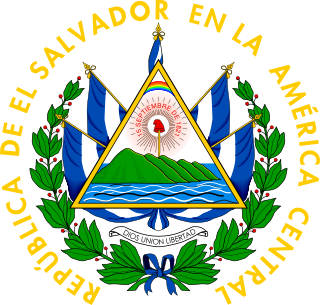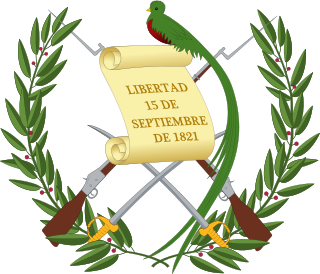
Manuel José Estrada Cabrera was the President of Guatemala from 1898 to 1920. A lawyer with no military background, he was a dictator who modernised the country's industry and transportation infrastructure, but only via granting concessions to the American-owned United Fruit Company, whose influence on the government was deeply unpopular among the population. Estrada Cabrera used increasingly brutal methods to assert his authority, including armed strike-breaking, and he effectively controlled the general elections. He retained power for 22 years through controlled elections in 1904, 1910, and 1916, and was eventually removed from office when the national assembly declared him mentally incompetent, and he was jailed for corruption.

Legislative elections were held in El Salvador on 31 March 1985. The result was a victory for the Christian Democratic Party, which won 33 of the 60 seats. Voter turnout was 42%.

Parliamentary elections were held in Guatemala between 24 and 26 January 1947 in order to elect half the seats in Congress. The Revolutionary Action Party won a plurality of seats.

General elections were held in Guatemala between 6 and 8 February 1931. In the presidential election Jorge Ubico was elected unopposed, after the remaining sector of the old Liberal Party did not object to his candidacy, whilst the Conservative Party was too disorganised and discredited from the Lázaro Chacón González era to put forward a candidate. Ubico's Progressive Liberal Party, formed by a union of the two wings of the divided Liberal Party also won the parliamentary election unopposed.

Presidential elections were held in Guatemala during seven days in September 1898. Prior to the elections Manuel Estrada Cabrera had established the first real political party in the country's history by admitting people from outside the influential liberals to the Liberal Party.

Presidential elections were held in Guatemala in July 1904. The result was a victory for Manuel Estrada Cabrera, who received all but three of the valid votes. He assumed the presidency on 15 March 1905.

Presidential elections were held in Guatemala on 11 April 1910. Manuel Estrada Cabrera was re-elected unopposed. He assumed the presidency on 15 March 1911.

Indirect presidential elections were held in Guatemala on 8 April 1920. After two decades of repression and dictatorial rule, political opponents of Manuel Estrada Cabrera organized the Unionist Party (PU) in 1919. Led by Conservatives tied to the landed oligarchy, the Unionists also attracted support among the urban proletariat, artisans, students, and industrialists.

Constituent Assembly elections were held in Honduras on 20 April 1980. In July the Assembly elected Policarpo Paz García as president.
General elections were held in Honduras on March 28, 1971. Voters went to the polls to elect a new President of the Republic and a new Congress. The two main parties, the National Party and Liberal Party, had agreed before the election to split the Congressional seats equally between them, with each party being awarded 32 of the 64 seats. Additional one seat was to be allocated to the winner of the presidential elections as the president was entitled to one seat in parliament, while both parties were to be equally represented in the Supreme Court in all state institutions including the Government. Ramón Ernesto Cruz Uclés of the National Party won the presidential election with 53% of the vote. Approximately 40% out of total of around 900,000 voters abstained from voting at the elections. Some of the major topics at the elections was the issue of commitment to continued participation in the Central American Common Market and approach to the relations with El Salvador after the Football War.

Constituent Assembly elections were held in Honduras on 12 February 1965. The Constituent Assembly subsequently elected Oswaldo López Arellano as president.

General elections were held in Honduras on 10 October 1948. The elections were boycotted by the Liberal Party as the party was restricted from campaigning. Instead, they called for the electorate to abstain from voting.
General elections were held in Nicaragua on 4 November 1984, to elect a president and parliament. Approximately 1.2 million Nicaraguans voted, representing a 75% turnout, with 94% of eligible voters registered. Impartial observers from international groupings such as the European Economic Community, religious groups sent to monitor the election, and observers from democratic nations such as Canada and the Republic of Ireland concluded that the elections were generally free and fair.
Federico Hernández de León was a Guatemalan writer, historian and journalist. He graduated from the Instituto Nacional Central para Varones of Guatemala, with a high school diploma in 1900. Active politically, was arrested during the last few years of the government of president Manuel Estrada Cabrera, being held in the Central Penitentiary of Guatemala until the president was deposed on April 14, 1920. After his release, he went straight to take over the Diario de Centro América semi-official newspaper of Guatemala at the time. Later, he directed Nuestro Diario along with Carlos Bauer Aviles.

Antonio Macías del Real (1866–1939) was a Spanish writer and pharmacist who moved to Guatemala where he wrote for most prestigious cultural publications. Among his articles are those that we wrote for La Ilustración Guatemalteca during the last year of general José María Reina Barrios presidency. When the president was assassinated on 8 February 1898, Macías del Real wrote Perfiles biográficos de don Manuel Estrada Cabrera (Biographical profiles of Mr. Manuel Estrada Cabrera, who had been appointed as interim President; Macias del Real kept writing on behalf of the new president since then. In 1902 his adulation paid off, as Estrada Cabrera granted him the Pacific Railroad concession. According to Guatemalan historian Rafael Arévalo Martínez in his book ¡Ecce Pericles!, Macías del Real -a pharmacist graduated from Universidad Central de Madrid and later incorporated in Guatemala- was the one that gave Estrada Cabrera a potent venom that the latter used to get rid of his opponents.

Presidential elections were held in Guatemala in November 1873. The result was a victory for Justo Rufino Barrios.

Presidential elections were held in Guatemala in November 1880.

Presidential elections were held in Guatemala in January 1892. The result was a victory for José María Reina Barrios.

The Totoposte Wars were three military conflicts fought in Central America between 1890 and 1906. The First Totoposte War occurred during the presidency of Manuel Lisandro Barillas Bercián in Guatemala, after the overthrow of Salvadoran President Francisco Menéndez by General Carlos Ezeta in El Salvador, which caused the exile of many Salvadorans who took refuge in Guatemala and who requested the help of President Barillas Bercián to stop the armies of Ezeta. The Second Totoposte War arose after the opposition of Guatemalan President Manuel Estrada Cabrera to the integration of Guatemala with the Greater Republic of Central America since Estrada Cabrera was more inclined to work with the government of the United States. The Third Totoposte War occurred in 1906 in similar conditions. In all three wars, the Guatemalan people mockingly referred to the war as the "Totoposte War" because it only served to consume large amounts of this corn-based food, without actually fighting.
Anarchism in Guatemala emerged from the country's labor movement in the late 19th century. Anarcho-syndicalism rose to prominence in the early 20th century, reaching its peak during the 1920s, before being suppressed by the right-wing dictatorship of Jorge Ubico.










